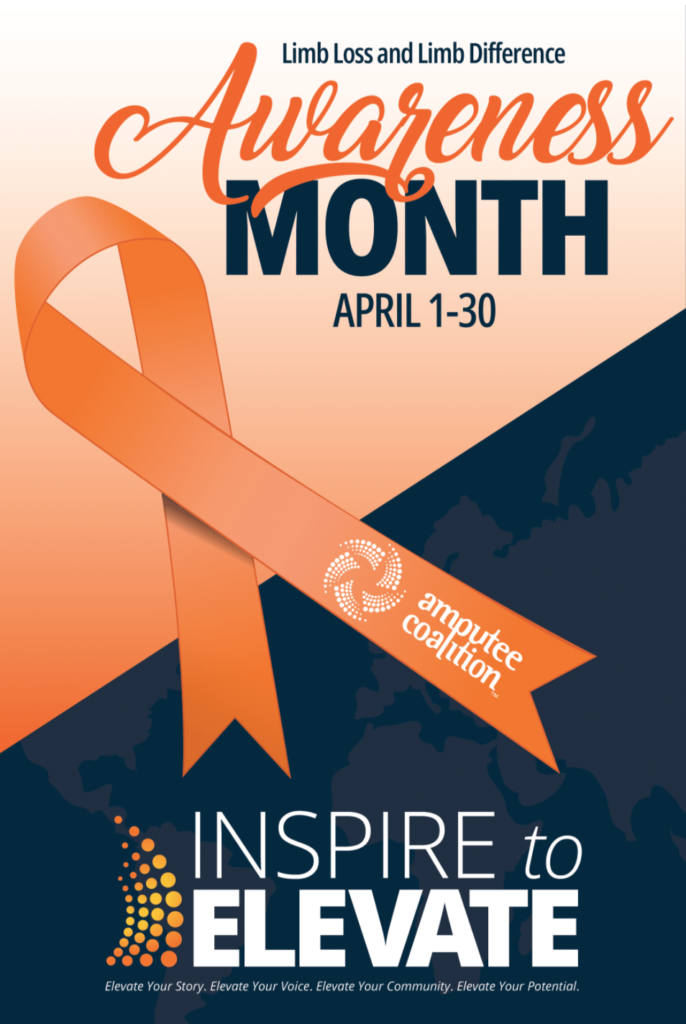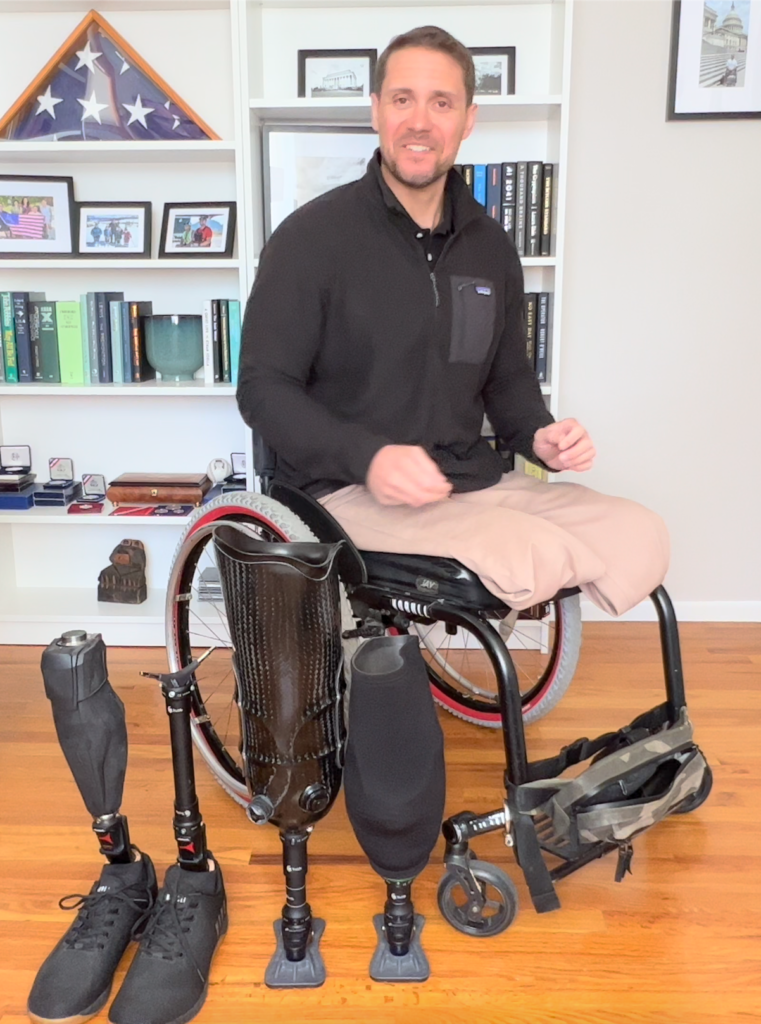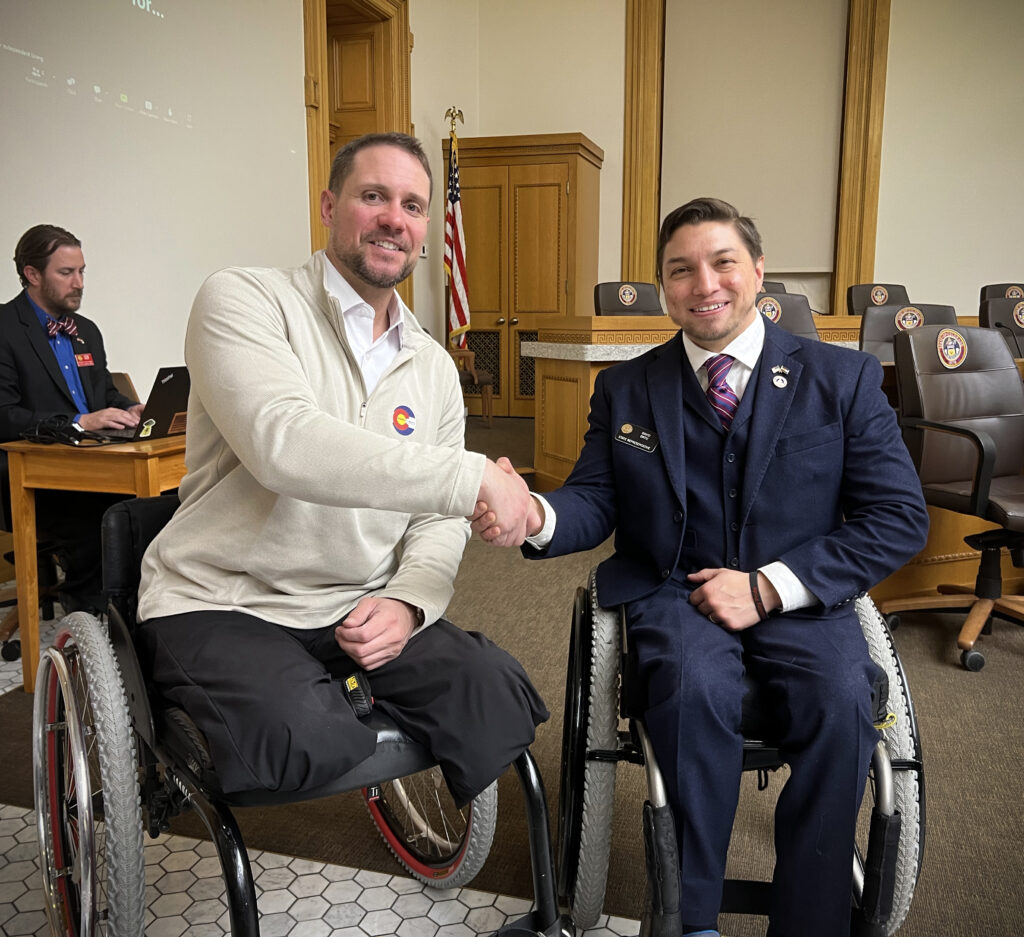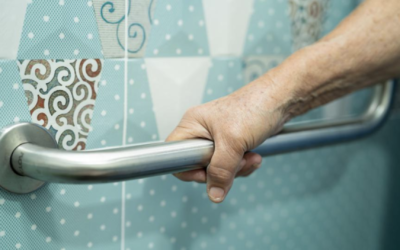Limb Loss Awareness Month
More than 2.7 million Americans live with limb loss. This number is expected to double by 2050. Approximately 185,000 amputations occur in the United States each year.
 April is Limb Loss and Limb Difference Awareness Month. Building on advocacy and initiatives for people with limb loss since 1986, in 2010, The Amputee Coalition designated April as Limb Loss and Limb Difference Awareness Month. This year, they are calling on people to “Inspire to Elevate” around four themes: “Elevate Your Story, Elevate Your Voice, Elevate Your Community, and Elevate Your Potential,” in service of honoring the limb loss and limb difference community and education others about living with limb loss or limb difference (note: for brevity, in this article we will use “limb loss” to refer to limb loss and limb difference).
April is Limb Loss and Limb Difference Awareness Month. Building on advocacy and initiatives for people with limb loss since 1986, in 2010, The Amputee Coalition designated April as Limb Loss and Limb Difference Awareness Month. This year, they are calling on people to “Inspire to Elevate” around four themes: “Elevate Your Story, Elevate Your Voice, Elevate Your Community, and Elevate Your Potential,” in service of honoring the limb loss and limb difference community and education others about living with limb loss or limb difference (note: for brevity, in this article we will use “limb loss” to refer to limb loss and limb difference).
By sharing stories, we create understanding and awareness of the challenges people with limb loss face, which cultivates a quality of empathy that brings people together to create a more equitable society. This month we want to give you a glimpse into the experience of limb loss and talk about how we can work together to help pass new legislation that would drastically improve the lives of people with limb loss.
Living with limb loss has unique challenges. Lifetime healthcare costs are approximately $150,000 higher for people with limb loss than those who are able-bodied. Mental health is also an issue, as approximately 36% of people living with limb loss face depression. However, recent research shows that prosthetic rehabilitation positively impacts quality of life, mobility, satisfaction, and mental health, and can lead to a reduction in overall direct healthcare costs. Data shows that if a prosthesis is received within the first 3 months following limb loss, saving of $100,000 or more in overall health costs can be had, and people are more likely to engage in healthy, active lifestyles. A bill has been introduced to the Colorado State Congress to ensure that prosthesis is more equally available for people who experience limb loss. HB 23-1136 will require insurance carriers to cover the cost of a second prosthetic device that would allow for recreational activities. Currently, only one prosthetic device that is deemed “medically necessary” is covered under insurance. This is usually a device that allows for basic functions, such as walking. The current law only covers functional prosthetics and excludes recreational prosthetics that are required for more active physical use. If someone regularly runs on an everyday prosthetic foot, for example, it could lead to bodily injury and greatly reduce the lifespan of the prosthetic. To pay for a prosthetic device out of pocket can cost from $5,000 – $50,000. This cost barrier has led many people to go without devices that would allow them to live active, healthy lives.
Experiencing Limb Loss

Craig Towler, Community Advocate for CPWD. Image description: Craig sits in his wheelchair. He has short brown hair and is wearing a black shirt and tan pants. On the ground in front of him are two pairs of prosthetic legs. One set has sneakers on the end, and the other set ends in flat grey pads. Behind him is a bookshelf with various photos and books.
Craig Towler is the Community Advocate for the Center for People with Disabilities. He is also an amputee. He understands the importance of HB 23-1136. Before he lost his legs, Craig was an active trail runner and worked as a triathlon event coordinator. He lost both of his legs in an accident on July 4, 2016. While he was pulling items out of the trunk of his car, an inebriated driver who was also texting, slammed into the back of another car parked behind him. This car launched forward and crushed Craig against the bumper of his vehicle, shattering his legs.
“I remember looking down and seeing that both of my legs had been crushed and were barely attached just by a few pieces of skin. I could see very vividly bone fragments shattered on the ground and a lot of blood everywhere.”
Craig had a crowd of people come to his aid while he waited for an ambulance. He ended up being hospitalized for more than a month. While in the hospital, he was given a choice. He could either use insurance to cover the cost of a wheelchair, or the cost of prosthetic legs, but insurance wouldn’t cover the cost of both even though he would need both throughout his life to live a high-quality active lifestyle. So Craig chose the prosthetics for his legs since they were the more expensive of the two. The doctors told him he would be able to use them within a few months. But now, seven years later, he can still only use them for very short periods of time. In the end, having the wheelchair covered by insurance would have been the smarter choice, but he had no way of knowing that at the time.
When Craig was released from the hospital, he realized there was a large gap in the information he received while transitioning to this new way of life. His caseworker at the hospital helped him become independent enough to live on his own and he had help from occupational and physical therapists, but once he left the hospital, he still had many questions and didn’t know who to contact for information and assistance.
“Transitioning from hospital to home, I really experienced a lot of barriers to living independently again and getting back to my regular life. And that’s what really introduced me to the need of being a self-advocate and understanding my rights.”
From there it grew into understanding broader disability rights issues that affect everyone with a disability, not just himself as an amputee. Seeing the bigger picture, Craig wanted to expand his advocacy to include the larger disability community. He learned that several of the issues he dealt with during self-advocacy were often built into the systems through policy and laws, and that’s why there is a need for a systemic approach to solving these issues. This was when he joined CPWD to be a full-time advocate.
“Now with my role at CPWD,” said Craig, “we not only assist with self-advocacy and helping people understand their rights and what they should have access to, but we also help on a systemic level dealing with policymakers and decision-makers.”
Currently, Craig, with the full support of CPWD, is advocating for HB 23-1136 so insurance will cover secondary prosthetic devices for recreational use.
“Not only as a member of the limb loss community myself do I understand the importance of physical activity, but from a disability rights perspective it is extremely important to make sure that every person has the independence and agency to make choices about their quality of life independently and not be forced to get approval from some third party or doctor to tell them what is necessary and what is not for their own life. That’s why this is not only an amazing bill to help support people being active in the limb loss community, but also it is a really important disability rights bill that will help expand what being independent really is for people with disabilities.”
The Bill
Shaneis Kehoe is a prosthetic and orthotic clinician who ran a mobility clinic for kids for two years. She would watch kids excel using recreational prosthetics in her clinics, but then hit a wall of frustration when they had to switch back to the standard prosthetics for the rest of their lives once out of the clinic. Kehoe’s frustration mounted to the point where she left her practice to pursue the fight for legislation requiring insurers to cover sports prosthetics. She joined Rocky Mountain Prosthetics and Orthotics Coalition, and together they reached out to Rep. David Ortiz to sponsor the bill for insurance to cover a secondary recreational prosthetic device. Ortiz is a veteran and uses a wheelchair. He immediately agreed.

Craig Towler shakes the hand of representative David Ortiz, the sponsor of HB 23-1136. Image description: Both men sit in wheelchairs shaking hands and looking at the camera, smiling. Craig, seated on the left, wears a tan sweater over a white collared shirt and black pants. He has brown hair and a beard. His pants are folded underneath him at the knee where his legs end. Rep. David Ortiz is seated right and is wearing a blue suit with a striped purple and pink tie. Behind them is a man at a desk looking at a laptop. There is a cabinet and several brown chairs.
“Not only is it the right thing to do from a moral standpoint,” Ortiz said about the bill in an interview with CBS, “from a social justice standpoint, economically it’s the right thing to do for how much it is going to save in healthcare costs, whether physical or mental health down the line.”
Knowing that the biggest argument against the bill would be added cost, Shaneis Kehoe ran a fiscal assessment. Her results showed that it would increase insurance premiums by less than ten cents per month, she said in an interview with CBS News Colorado.
On March 21, HB 23-1136 passed the House Health and Insurance Committee 11-0 with full bi-partisan support. Now it is waiting to be scheduled for review by the appropriations committee. Once it is scheduled for review by the house appropriations committee, the bill will be voted on again. If it is approved in appropriations, it will go on to the Senate committee hearing and go through the same process through the Senate. It then goes to the floor of the House for a vote, and then to the floor of the Senate. If it passes all these reviews and votes, it will then go on to the Governor’s desk to be either signed and approved or vetoed. This session of the State Congress ends in early May, so time is running out and supporters of the bill fear it could be dead in the water before it can even make it to the House and Senate floors to be voted on.
“We need to let the people who represent us know what is important to us because they represent us. We are urging everyone to actively reach out to your representatives here in the state of Colorado,” said Craig. “Let them know that this piece of legislation is important to you. Let them know that disability rights matter, and that everyone should have equal and equitable access to the medical devices they need to live high-quality lives.”
For information about how to contact your representatives, and scripts that can help you communicate, you can follow this link for detailed information.





